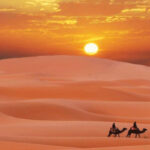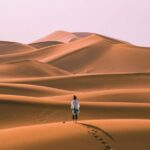Step into the magical world of nomadic life around Erg Chigaga. This vast desert is breathtaking. The nomads here live in perfect harmony with nature, keeping their traditional ways alive. You can dive into this enchanting culture by joining a guided tour.
This tour lets you see the desert’s stunning dunes and learn about local traditions. It’s a unique chance to explore and discover.

There’s so much to do here. You can go on camel rides, gaze at the stars, and visit traditional Berber villages. You’ll also find luxurious camps to relax in.
The nomadic life is simple yet strong. It’s all about living in tune with nature.
Key Takeaways
- Explore the majestic dunes of Erg Chigaga on a camel ride
- Experience the traditional Berber culture and lifestyle
- Enjoy stargazing in the clear desert skies
- Visit local villages and learn about the community’s traditions
- Relax in luxurious camps amidst the desert landscape
The Magnificent Desert of Erg Chigaga
Erg Chigaga is a stunning desert in Morocco, showing the Sahara’s natural beauty. It’s not just a beautiful sight but also has deep cultural and historical value.
Geographic Location and Unique Features
Erg Chigaga lies in Morocco’s southwest, in the Sahara Desert. It boasts towering sand dunes, some over 50 meters high. The erg changes with the wind, making it unique.
This desert is special because it’s far from tourist spots, offering a real desert feel. It also has beautiful oases with palm groves and traditional water systems. These support local plants and animals.
The Cultural Significance of Morocco’s Sand Dunes
The sand dunes of Erg Chigaga are more than just a natural wonder. They hold deep cultural meaning. They’ve seen history unfold and are vital to local nomadic communities.
Historical Trade Routes Through the Region
For centuries, Erg Chigaga was a key stop for Sahara trade caravans. Merchants and travelers passed through, trading goods like salt, gold, and spices. This history shapes the local Berber and Tuareg cultures.
The area’s rich history is seen in its cultural diversity and heritage. Erg Chigaga is more than a desert; it’s a window into Morocco’s past and culture.
Who Are the Nomads of Erg Chigaga?
For centuries, the nomads of Erg Chigaga have learned to survive in Morocco’s toughest desert. The Erg Chigaga desert, with its huge dunes and harsh weather, is home to the Berber and Tuareg tribes. These groups have developed special ways of living that fit perfectly with the desert.
The Berber and Tuareg Communities
The Berber and Tuareg communities around Erg Chigaga have a rich culture. The Berbers, also known as Imazighen, are the original people of North Africa. They have kept their language and culture alive, even through tough times. The Tuareg, known for their blue robes, are experts in desert trade.
- The Berbers love telling stories and making music.
- The Tuareg are great at navigating the desert.
- Both groups make unique crafts like jewelry and leatherwork.
Seasonal Migration Patterns
The nomads of Erg Chigaga move with the seasons to find food for their animals and avoid the desert’s worst weather. These migrations are key to their survival, as they move between summer and winter grazing areas. For more info on visiting Erg Chigaga, check out this guide.
Adaptation to Harsh Desert Conditions
Living in the harsh desert is a big challenge for the nomads of Erg Chigaga. They have found ways to survive, like:
- Wearing thick clothes to keep warm and protect from sand.
- Using old knowledge to find water.
- Building shelters to keep safe from sandstorms.
Their ability to adapt shows their strength and deep understanding of the desert.
Planning Your Visit to Experience Nomadic Life
Planning your visit to Erg Chigaga is key to experiencing nomadic life. The desert’s vastness and nomads’ migrations affect your visit. The right time can make your experience more real.
Optimal Seasons for Witnessing Nomadic Activities
The best times to see nomadic life at Erg Chigaga are spring (March to May) and autumn (September to November). These seasons have mild weather, perfect for both nomads and visitors.
During these times, you can see nomads doing:
- Livestock herding
- Traditional cooking
- Craft-making demonstrations
Duration Recommendations for Authentic Experiences
For a real experience, stay at least 3 to 5 days in Erg Chigaga. This lets you dive into nomadic culture, join in activities, and enjoy the desert’s calm.
Budgeting for Your Desert Adventure
When planning your Erg Chigaga trip, think about costs like tours, places to stay, and activities. Prices vary, but expect to spend $100 to $300 daily. This depends on your choices of where to stay and who to tour with.
By visiting during the best seasons and planning your budget, you’ll have a memorable trip. You’ll enjoy the stunning dunes of Erg Chigaga.
How to Travel to Erg Chigaga Responsibly
Traveling to Erg Chigaga responsibly means using sustainable practices and helping local communities. As more people visit this Moroccan desert, it’s important to leave a small environmental mark. Also, we should help the local economy grow.
Sustainable Transportation Options
Choosing the right way to get there is key to responsible travel. Look for eco-friendly tour operators who use cars that don’t pollute much. Or, choose camel trekking for a greener option.
- Choose tour operators with a strong environmental policy.
- Opt for carpooling or group tours to reduce the number of vehicles on the road.
- Consider camel or donkey treks for a more traditional and environmentally friendly mode of transport.
Selecting Ethical Tour Operators
When picking a tour operator, look for those that support local communities. They should be open about how they run their business. Make sure they pay local guides and staff fairly.
- Research the operator’s policies on local employment and community support.
- Check for reviews and testimonials from other travelers.
- Ask about their environmental practices and how they minimize their impact on Erg Chigaga.
Supporting Local Nomadic Communities
Helping local nomadic communities is easy. Just buy their crafts or join a traditional tea ceremony. These actions help the local economy and promote cultural exchange.
By making smart choices, visitors can make their trip to Erg Chigaga both unforgettable and eco-friendly.
Essential Gear for Your Erg Chigaga Expedition
Erg Chigaga’s harsh desert environment needs careful planning and the right gear. A successful journey through this Moroccan desert requires detailed preparation.
Desert-Appropriate Clothing and Footwear
Choosing the right clothing and footwear is key for Erg Chigaga’s vast dunes. Lightweight, breathable clothing that protects against the sun and sand is essential. Also, sturdy, comfortable footwear that can withstand the harsh desert terrain is a must.
- Loose-fitting cotton clothing
- Sturdy hiking boots
- Protective headgear and sunglasses
Photography Equipment Protection
Capturing Erg Chigaga’s beauty requires protecting your photography equipment from harsh desert conditions. Using protective cases and filters can help safeguard your gear.
- Use a camera with good dust protection
- Invest in a sturdy tripod for stability
- Keep your equipment clean and dry
Health and Safety Supplies
Ensuring your health and safety in Erg Chigaga involves packing the right supplies. A first-aid kit, along with supplies for hydration and sun protection, is vital.
- First-aid kit with essentials
- Water and hydration packs
- Sunscreen and lip balm with SPF
By carefully selecting and packing the right gear, you’ll be well-prepared for Erg Chigaga’s challenges and wonders. Remember, preparation is key to a successful and enjoyable desert expedition.
Step-by-Step Guide to Experiencing Nomadic Hospitality
To really get into the nomadic way of life, you need to understand and join in their hospitality. The nomadic groups near Erg Chigaga are famous for their friendly welcomes and deep cultural traditions.
Participating in Traditional Tea Ceremonies
One key part of nomadic hospitality is the traditional tea ceremony. Moroccan mint tea is a big deal in these meetings, showing friendship and respect. Here’s how to do it right:
- Accept the tea with your right hand, as using your left hand is considered impolite.
- Chat while you drink your tea, as this is a time for making friends.
- Thank the host for the tea, showing you appreciate their effort.
Learning Basic Berber Phrases
Knowing a few basic Berber phrases shows you respect the nomadic culture. Here are some important ones:
| Phrase | Meaning |
|---|---|
| Azul | Hello |
| Marhaba | Welcome |
| Shukraan | Thank you |
Gift-Giving Etiquette with Nomadic Families
When you visit nomadic families, it’s good to bring a gift as a sign of respect. Think about bringing:
- Tea or spices, which are always welcome.
- Small handicrafts or toys for the kids.
- Clothing or fabric for the family to use.
Give your gift with your right hand and a smile. This shows you’re coming in peace and friendship.
Observing Daily Nomadic Activities Around Erg Chigaga
The vast dunes of Erg Chigaga are a stunning backdrop for the nomadic communities’ daily life. It’s a sight that captivates anyone who visits. The nomads’ daily activities blend tradition with adapting to the harsh desert environment.
Livestock Herding Practices
Livestock herding is key to nomadic life around Erg Chigaga. The nomads manage their herds well, making sure they don’t overgraze. This helps their livestock and keeps the desert ecosystem healthy.
The herders use old techniques passed down through generations. They work with nature to keep a balance between their needs and the land’s limits.
Traditional Cooking Methods
Nomadic cooking is simple yet tasty. It often involves cooking over open fires or using portable clay ovens. Meals usually include grains, dates, and sometimes meat.
Visitors might get to share in these meals. It’s a chance to really experience nomadic culture. The nomads’ hospitality is a big part of their culture.
Craft-Making Demonstrations
Nomadic communities around Erg Chigaga are skilled in crafts like weaving, pottery, and jewelry making. These crafts are not just useful but also carry deep cultural meaning. They often show status, spirituality, or community ties.
| Craft | Materials Used | Cultural Significance |
|---|---|---|
| Weaving | Wool, Dyes | Symbolizes community status |
| Pottery | Clay, Water | Used in traditional cooking |
| Jewelry Making | Silver, Beads | Signifies spiritual protection |
Participating in Nomadic Chores
Visitors to Erg Chigaga can join in nomadic chores. It’s a way to really understand nomadic life and its challenges. Activities can include helping with livestock or making crafts.
Doing these activities makes the visitor’s experience richer. It also builds a connection and respect between the nomads and their guests.
Capturing the Beauty of Nomadic Life
Photography can show the beauty of nomadic life in Erg Chigaga. It’s important to do it with respect and knowledge. When you visit Erg Chigaga, you can document the rich culture of nomadic communities.
Respectful Photography Guidelines
It’s key to follow respectful photography rules. Always ask before taking someone’s picture. Be ready to say how you’ll use the photo. Knowing and respecting local customs makes your photos better.
Some nomadic groups have rituals not to be photographed. Knowing these rules helps avoid offense. It also helps you connect well with the community.
Best Times for Desert Light
The desert light in Erg Chigaga is stunning, especially in the early morning and late afternoon. These times give soft, warm light that makes photos better. Plan your shoots for these times to get great photos.
Documenting Cultural Practices Ethically
It’s important to document cultural practices ethically. This means respecting the people you photograph and understanding the cultural practices. This way, you create a meaningful and respectful visual story of nomadic life in Erg Chigaga.
By using your photography skills with cultural awareness, you can show the beauty of nomadic life. Your photos will be both respectful and artistic.
Navigating Cultural Differences with Respect
Respecting cultural differences is key to a harmonious and enjoyable visit to Erg Chigaga. The nomadic communities surrounding this magnificent desert are rich in tradition and custom. Understanding these nuances can greatly enhance your experience.
Gender Considerations in Nomadic Communities
In many nomadic cultures, including those around Erg Chigaga, gender roles are deeply ingrained. Men and women often have distinct responsibilities and social expectations. Visitors should be aware of these differences to avoid unintentionally offending their hosts.
Certain areas or activities may be reserved for specific genders. This is important to remember.
Religious Practices and Observances
The nomadic communities of Erg Chigaga are predominantly Muslim, and Islamic practices play a significant role in daily life. Visitors should respect local religious customs, such as during Ramadan or when visiting nomadic families.
Being mindful of prayer times and dressing modestly can demonstrate respect for these practices.
Appropriate Dress and Behavior
Dressing appropriately is crucial when interacting with nomadic communities. Loose, modest clothing that covers the shoulders and knees is recommended. Additionally, removing shoes before entering tents or homes is a sign of respect.
Understanding and adopting these practices can foster a positive and respectful interaction.
By being mindful of these cultural differences and adapting your behavior accordingly, you can ensure a respectful and enriching experience for both yourself and the nomadic communities you encounter.
Conclusion: Preserving the Legacy of Desert Nomads
Exploring the nomadic life around Erg Chigaga gives us a rare look into a centuries-old way of life. As you wander through the vast desert and meet the Berber and Tuareg people, it’s clear we must protect their traditions.
Many tours, like the Randonnée dans le désert et visite d’une école nomade or Trekking d’Agadir au Désert de Chigaga, let you dive into nomadic culture. You can find more about these tours and plan your trip on the Foum Zguid Desert website.
Supporting local guides and communities helps keep nomadic traditions alive and the Erg Chigaga environment safe. As we explore, it’s key to respect the cultural heritage of its people.
Preserving the nomadic legacy needs a careful and eco-friendly tourism approach. By being aware of our actions and connecting with locals, we can safeguard Erg Chigaga and its unique culture for the future.
FAQ
What is Erg Chigaga, and where is it located?
Erg Chigaga is a vast desert area in Morocco. It’s famous for its huge sand dunes and nomadic communities. It’s found in the southeastern part of the country, near Algeria.
What are the best times to visit Erg Chigaga to experience nomadic life?
The best times to visit Erg Chigaga are spring (March to May) and autumn (September to November). The weather is mild, and nomadic activities are at their peak.
How can I participate in traditional nomadic activities around Erg Chigaga?
You can join local nomadic families or take guided tours to participate in activities. These include herding livestock, cooking, and making crafts.
What should I pack for a trip to Erg Chigaga?
Pack desert-friendly clothes and shoes, and protect your camera. Don’t forget sunscreen, a first-aid kit, and a water filter or purification tablets.
How can I ensure that my visit to Erg Chigaga is culturally sensitive and responsible?
Respect local customs and dress modestly. Learn some Berber phrases. Choose ethical tour operators that support the community and follow photography guidelines.
Can I stay with nomadic families, and what are the benefits of doing so?
Yes, you can stay with nomadic families through homestays or guided tours. It’s a great way to experience their hospitality and learn about their lives. You also support the community directly.
What are the most important cultural practices to respect when visiting Erg Chigaga?
Respect local customs, including gender and religious practices. Dress modestly and remove shoes when entering homes. Be careful with your photos and follow any photography rules.



